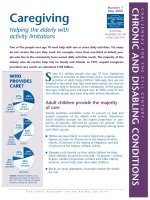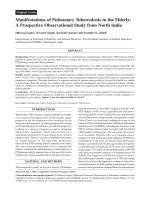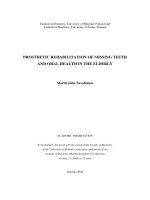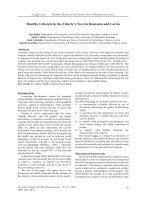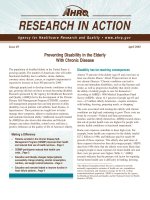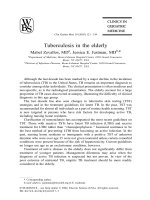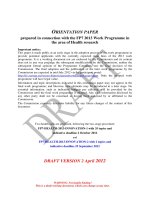Preventing Disability in the Elderly With Chronic Disease doc
Bạn đang xem bản rút gọn của tài liệu. Xem và tải ngay bản đầy đủ của tài liệu tại đây (354.18 KB, 8 trang )
The population of disabled elderly in the United States is
growing rapidly. The number of Americans who will suffer
functional disability due to arthritis, stroke, diabetes,
coronary artery disease, cancer, or cognitive impairment is
expected to increase at least 300 percent by 2049.
1
Although people tend to develop chronic conditions as they
age, growing old does not have to mean becoming disabled.
Research sponsored by the Agency for Healthcare Research
and Quality (AHRQ) led to the development of the Chronic
Disease Self-Management Program (CDSMP), a patient
self-management program that can help prevent or delay
disability even in patients with arthritis, heart disease, or
hypertension.
2
These patients are taught how to better
manage their symptoms, adhere to medication regimens,
and maintain functional ability.
2
Additional research funded
by AHRQ has also shown that education and lifestyle
changes can reduce disability, control costs, and have a
positive influence on the quality of life of America’s elderly.
Disability has far-reaching consequences
Almost 75 percent of the elderly (age 65 and over) have at
least one chronic illness.
3
About 50 percent have at least
two chronic illnesses.
3
Chronic conditions can lead to
severe and immediate disabilities, such as hip fractures and
stroke, as well as progressive disability that slowly erodes
the ability of elderly people to care for themselves.
4
According to AHRQ’s 1996 Medical Expenditure Panel
Survey (MEPS),
a
about 14.3 percent of people age 65 and
over—4.5 million elderly Americans—require assistance
with bathing, dressing, preparing meals, or shopping.
5
The costs associated with treating the elderly with chronic
conditions are high and continuing to grow. These costs are
borne by everyone—Federal and State governments,
families, and the elderly themselves. AHRQ research shows
that out-of-pocket health costs are highest for people with
chronic health conditions or functional impairment.
6
Home care expenses contribute to these high costs. For
example, home health care expenses for the elderly totaled
$27.2 billion in 1996, and Medicare paid for nearly 60
percent of these expenses.
7
The elderly also paid more of
these expenses themselves than did younger people.
7
MEPS
data from 1996 show that the elderly were more likely than
younger people to incur expenses for home health care and
their costs per person were higher (Table 1).
7
AHRQ
research indicates that the primary risk factor for requiring
formal home health care is difficulty in bathing, dressing,
Preventing Disability in the Elderly
With Chronic Disease
Making a Difference
• Patients enrolled in the Chronic Disease Self-
Management Program (CDSMP) improved their health
and reduced their use of health services…Page 2
• CDSMP participants reduced their health care
costs…Page 3
• Education and lifestyle changes helped patients
successfully change smoking, alcohol consumption,
nutrition, and weight control behaviors…Page 4
• Education and exercise helped to improve function in
heart failure patients…Page 4
RESEARCH IN ACTION
Agency for Healthcare Research and Quality • www.ahrq.gov
Issue #3 April 2002
a
The Medical Expenditure Panel Survey is conducted to provide
nationally representative estimates of health care use, expenditures,
sources of payment, and insurance coverage for the U.S. civilian
noninstitutionalized population. MEPS is cosponsored by the Agency
for Healthcare Research and Quality and the National Center for Health
Statistics (NCHS).
eating, or using the toilet.
8
Many elderly people can
maintain or improve their functional ability by attending the
CDSMP and practicing its principles.
CDSMP improved health and reduced health care
use
AHRQ-funded research at the Stanford University Patient
Education Research Center led to the development of the
CDSMP. The CDSMP is a 17-hour course taught by trained
lay people that teaches patients with chronic disease how to
better manage their symptoms, adhere to medication
regimens, and maintain functional ability.
2
Offered in
community settings such as senior centers, churches,
libraries, and hospitals, CDSMP classes are held once a
week for 7 weeks.
2
This program has been so successful, it
has been implemented both nationally and internationally.
9
Over a period of 2 years, AHRQ-funded investigators
compared health behaviors, health status, and health
services use in patients age 40 to 90 years (average age, 65)
who had completed the CDSMP. When compared to
baseline measures taken for the 6 months prior to the
CDSMP, researchers found that:
After 6 months, CDSMP participants had—
• Increased exercise.
• Better coping strategies and symptom management.
• Better communication with their physicians.
• Improvement in their self-rated health, disability, social
and role activities, and health distress.
• More energy and less fatigue.
• Decreased disability.
• Fewer physician visits and hospitalizations.
2
After 1 year, CDSMP participants had—
• Significant improvements in energy, health status, social
and role activities, and self-efficacy.
• Less fatigue or health distress.
• Fewer visits to the emergency room.
• No decline in activity or role functions, even though
there was a slight increase in disability after 1 year.
10
After 2 years, CDSMP participants had—
• No further increase in disability.
• Reduced health distress.
• Fewer visits to physicians and emergency rooms.
• Increased self-efficacy.
10
The increase in patients’ perceptions of their self-efficacy
was associated with reduced health care use.
10
Self-efficacy,
the degree of belief people have that they can perform the
behavior required to produce a desired outcome, is crucial
to the success of the CDSMP.
2
The more self-efficacy
people have, the more control they believe they have over
www.ahrq.gov2
Table 1. Home health services use and expenses, 1996
Statistic Under age 65 Age 65 and over
Percent with expense 1% 13%
Average annual expense per person $3,342 $6,041
Percent paid out of pocket 2.7% 14.5%
Amount paid out of pocket $186 million $3.9 billion
Percent paid by Medicare 27.6% 58.9%
Amount paid by Medicare $1.9 billion $16 billion
Source: Cohen JW, Machlin SR, Zuvekas SH, et al. Health care expenses in the United States, 1996. Rockville (MD): Agency for Healthcare Research and Quality; 2000. MEPS Research
Findings No. 12. AHRQ Pub. No. 01-0009.
their behavior.
2,11
Therefore, increasing self-efficacy
contributes to better decisionmaking processes, stronger
motivation, and perseverance.
11
CDSMP reduced costs
The CDSMP saved from $390 to $520 per patient over the
2-year study period because participants used fewer health
care services. CDSMP participants used less hospital and
physician services than they had used before participating
in the program, and less than those who had not
participated in the CDSMP (the control group).
2,10
Specifically, researchers found that hospitalization rates for
CDSMP participants did not increase over the 2-year
duration of the study
.10
For example, during the first 6
months, CDSMP participants were hospitalized 0.15 fewer
days than they had been during the 6 months before they
began the program. Patients in the control group were
hospitalized 0.34 more days, making a total difference of
0.49 days.
10
If the cost to hospitalize a patient were $1,000
per day, cost savings attributed to the CDSMP would be
$490 per person (0.49 fewer days in the hospital multiplied
by $1,000).
10
CDSMP participants also had 2.5 fewer visits to the
emergency room and their physicians.
10
Assuming a
minimum reimbursement from Medicare of $40 for a
physician or emergency room visit, savings from the
CDSMP would be $100 per participant (2.5 fewer visits
multiplied by $40 per visit).
10
The CDSMP cost between $70 and $200 per person to
administer. After subtracting these costs from the savings
due to lower health services use, the total amount saved as
a result of the CDSMP over a 2-year period was estimated
at $390 to $520 per person.
2,10
Impact in a community setting continues
Further evidence of the effectiveness of the CDSMP can be
found in a study funded by Kaiser Permanente. One year
after completing the CDSMP, participants in the Kaiser
study showed significant improvements in fatigue,
shortness of breath, pain, social activity limitation, illness
intrusiveness, depression, and health distress. Participants
also reported improved exercise, symptom management,
and communication with their physicians.
12
In addition, Kaiser CDSMP participants had 0.2 fewer
visits to the emergency room and 0.97 fewer hospital days
compared to the year prior to completing the CDSMP. As a
result, they reduced their health care costs. For example, if
the average cost per day of hospitalization were $1,000 and
the average cost of an emergency room visit were $100, the
potential savings would be $990 per participant for the first
year following completion of the program (0.97 days of
hospitalization multiplied by $1,000 plus 0.2 emergency
visits multiplied by $100).
12
Kaiser Permanente paid approximately $200 per participant
for CDSMP training, materials, and administration. With
489 participants, Kaiser’s total cost was $97,800. However,
if the cost to care for each participant decreased $990
because participants used fewer health services, Kaiser
Permanente’s net savings would be nearly $400,000.
12
A final note: Kaiser Permanente’s enrollment in the
CDSMP grew to 2,500 participants in 2000.
12
In 2002, the
CDSMP won Kaiser Permanente’s James A. Vohs Award
for Quality.
13
This award (named in honor of Kaiser’s
longtime President, Chief Executive Officer, and
Chairman) acknowledges superior, creative programs that
improve the quality of patient care.
14
CDSMP has international impact
The National Health Service (NHS) of England has
adopted the CDSMP as the key educational offering in its
Expert Patient program.
13
The Expert Patient program is
based on the premise that people with chronic disease often
understand their condition better than their physicians do.
15
The NHS intends to help people with chronic disease
become “experts” in knowledge about their condition so
that they can develop disease management skills, consider
themselves partners with their health care providers, and
take greater responsibility for their health and health care.
15
Over a 6-year period, the NHS will implement self-
management programs such as the CDSMP for patients
with chronic disease.
15
CDSMP covers multiple chronic conditions
As discussed earlier, most elderly people contend with
more than one chronic illness. For example, during the
AHRQ-funded studies, patients in the CDSMP had an
average of two chronic conditions.
2,9,10
One advantage of the
www.ahrq.gov 3
CDSMP is that patients receive instruction on self-
management for several different chronic diseases by
attending only one course.
2
However, the CDSMP can also
be used in conjunction with disease-specific education
programs.
2
The CDSMP focuses on problems that are common to
patients suffering from chronic diseases. Coping strategies
such as action planning and feedback, behavior modeling,
problem-solving techniques, and decisionmaking are
applicable to all chronic diseases. Patients are taught to
control their symptoms through:
• Relaxation techniques.
• Changing their diets.
• Managing sleep and fatigue.
• Using medications correctly.
• Exercise.
• Communication with health providers.
In addition, patients receive information on sexual
relations, advance directives, nutrition, and pain
management.
2,9,10
Each person enrolled in the CDSMP receives the text
Living a Healthy Life With Chronic Conditions, 2nd
Edition
.
9
This manual, developed by Stanford University
School of Medicine researchers and supported by AHRQ,
teaches self-management behaviors for chronic lung
disease, heart disease, high blood pressure, arthritis, and
diabetes.
16
Currently, the CDSMP is offered by over 100
health organizations in 31 States and 10 countries—the
United States, Canada, Australia, New Zealand, Great
Britain, Italy, Norway, Hong Kong, China, and Sweden.
9,b
Education and lifestyle changes improve health
Other AHRQ research supports the health education and
lifestyle changes endorsed by the CDSMP. AHRQ
sponsored a comprehensive review of research on how
education and counseling interventions affect preventive
health behaviors. Although these studies focused on
prevention in healthy people, the consensus was that
behavioral techniques such as self-monitoring, personal
communication with health care providers, and viewing
audiovisual materials contribute to successful change for
behaviors such as quitting smoking, controlling alcohol
consumption, improving nutrition, and weight control.
17
Education that promoted exercise lifestyle changes
enhanced control of heart failure in another AHRQ-funded
study. Patients over the age of 30 who were taking
medication to control their heart failure underwent an
exercise program of walking at home 3 days a week.
Participants were taught how to monitor their heart rate and
exertion level. They also received instruction on resistance
exercises and multimedia material to take home regarding
safety and proper technique. At the end of 3 months,
patients who exercised reported less fatigue, decreased
shortness of breath, improved emotional functioning, and
better control over their symptoms than patients who did
not exercise.
18
AHRQ research supports national goals
A prime objective of Healthy People 2010,
19
the Nation’s
health promotion and disease prevention agenda, is to
improve the quality of life and longevity of adults with
chronic disease. Specifically, the objectives identified by
the U.S. Department of Health and Human Services are to:
• Reduce the number of adults who experience functional
limitations and limitations with activities of daily living
as a result of chronic joint problems.
• Increase the number of adults who seek help for coping
with their arthritis, who see a health care provider, and
who have had education about arthritis as part of their
overall medical management.
• Reduce the number of people who die as a result of
coronary artery disease or stroke through education,
screening, and control of high blood pressure and serum
cholesterol levels.
• Increase the proportion of older adults who participate
in an organized health promotion activity to 90 percent.
Implementation of the CDSMP and other AHRQ-funded
research that has been translated into practice clearly helps
the United States meet these goals.
www.ahrq.gov4
b
Stanford University offers a 4
1
/2 day training course to teach
representatives of health care organizations how to implement the
CDSMP. More information on the CDSMP can be found at the Stanford
Patient Education Research Center Web site:
< />Research to improve chronic disease outcomes
continues
AHRQ is continuing to fund research on health care for the
elderly and management of chronic disease for all age
groups. Ongoing studies include:
•
Education in an HMO: Effectiveness and Efficiency;
Grant No. R01 HS08641-01A1. This study is assessing
the short-term and long-term effectiveness of a health
education program (HEP) for spouse caregivers and frail
elderly care recipients. The researchers are examining
whether health education group programs offered by a
health maintenance organization (HMO) in a primary
care setting can reduce health services use and costs
while improving participants’ health status and well-
being.
•
Effect of Formal Home Care Services on Caregiver
Burden
; AHRQ Grant. No. R03 HS10794-01. This study
will provide a better understanding of the dynamics of
family caregiving to low-income and frail elderly
individuals living in the community. It is examining how
community and home care services diminish the effect
of stressors on caregiver burden.
•
A Patient Activation Approach to Improving Diabetes
Care
; Grant No. R18 HS10123-01A1. This study is
applying a patient-focused, behavioral-systems approach
to improving diabetes self-management. Investigators
are studying patient, physician, and practice
characteristics associated with compliance with
recommended guidelines for diabetes, including clinic
culture, patient autonomy, provider attitudes and
supportiveness of patient autonomy, and patient-provider
communication.
•
Spouse Involvement in Cardiac Patients’Behavior
Change
; Grant No. R03 HS11263-01. This study of
heart disease patients and their spouses is exploring
patient perceptions of supportive, controlling, and
undermining behaviors in response to recommendations
for adoption and maintenance of exercise activity. The
Transtheoretical Model of Behavior Change is the
primary method of promoting healthy behaviors such as
exercise to prevent disability due to heart disease.
New funding opportunities—researchers can
make a difference
AHRQ’s program announcement “Patient-Centered Care:
Customizing Care to Meet Patients’ Needs” is intended to
support the redesign and evaluation of new processes of
care that lead to greater patient empowerment, improved
patient-provider interaction, easier navigation through
health care systems, and improved access, quality, and
outcomes. Specific strategies could include, but are not
limited to, electronic clinical communication, self-
management programs, Web-based applications for patients
and/or health care providers, and shared decisionmaking
programs. AHRQ encourages projects that emphasize
chronic illness, episodes of care that extend beyond
hospitalization, longitudinal care, and priority populations.
More information can be found at
< grants/guide/pa-files/PA-01-124.html>.
www.ahrq.gov 5
AHRQ-Funded/Sponsored Research on Chronic Disease Management
• Improving Chronic Disease by Self-Management Education, Stanford University: This study developed, operated, and
evaluated the Chronic Disease Self-Management Program and assessed its effectiveness in improving health while
lowering costs for patients with chronic disease.
• Meta-Analysis of Studies Evaluating Patient Education, University of Texas Health Science Center: This study evaluated
different methods of patient education and examined their impact on preventive health behaviors.
• Home-Based Exercise in Patients with Heart Failure, University of California: This study compared a physical activity
program with usual care for improving physical performance and quality of life and well-being in patients with heart
failure.
Conclusion
Programs such as the CDSMP provide self-management
education for all patients with chronic disease and help
preserve functional ability while reducing costs. AHRQ-
funded research clearly indicates that health education and
lifestyle changes contribute greatly to reducing the negative
consequences of chronic disease. The lives of Americans
can be improved by implementing programs such as the
CDSMP and encouraging patients to take part in them.
Furthermore, this program can help the Nation achieve its
Healthy People 2010 goals and objectives: to reduce the
number of people who suffer from disability as a result of
chronic disease and to increase the number of people who
receive education and support for coping with their disease.
For more information
This synthesis was written by Barbara L. Kass-Bartelmes,
M.P.H., CHES (). For further information
on chronic disease, please contact the Center for Primary
Care Research at 301-594-1357.
References
1. Boult C, Altmann M, Gilbertson D, et al. Decreasing
disability in the 21st century: the future effects of
controlling six fatal and nonfatal conditions. Am J
Public Health 1996;86(10):1388-93.
*2. Lorig KR, Sobel DS, Stewart AL, et al. Evidence
suggesting that a chronic disease self-management
program can improve health status while reducing
hospitalization. A randomized trial. Med Care
1999;37(1):5-14.
3. Calkins E, Boult C, Wagner E, et al. New ways to care
for older people. Building systems based on evidence.
New York: Springer; 1999.
4. Fried LP, Guralnik JM. Disability in older adults:
evidence regarding significance, etiology, and risk. J Am
Geriatr Soc 1997;45(1):92-100.
*5. Banthin JS, Cohen JW. Changes in the Medicaid
community population: 1987-96. Rockville
(MD):Agency for Health Care Policy and Research;
1999. MEPS Research Findings No. 9. AHCPR Pub.
No. 99-0042.
*6. Crystal S, Johnson RW, Harman J, et al. Out-of-pocket
health care costs among older Americans. J Gerontol B
Psychol Sci Soc Sci 2000;55(1):S51-62.
*7. Cohen JW, Machlin SR, Zuvekas SH, et al. Health care
expenses in the United States, 1996. Rockville (MD):
Agency for Healthcare Research and Quality; 2000.
MEPS Research Findings 12. AHRQ Pub. No. 01-0009.
*8. Grabbe L, Demi AS, Whittington F, et al. Functional
status and the use of formal home health care in the year
before death. J Aging Health 1995;7(3):339-64.
9. Stanford Patient Education Research Center, Stanford
University School of Medicine, Department of
Medicine. Chronic Disease Self-Management Program
Web site: < />*10. Lorig KR, Ritter P, Stewart AL, et al. Chronic Disease
Self-Management Program: 2-year health status and
health care utilization outcomes. Med Care
2001;39(11):1217-23.
11. Lorig KR, Mazonson PD, Holman HR. Evidence
suggesting that health education for self-management in
patients with chronic arthritis has sustained health
benefits while reducing health care costs. Arthritis
Rheum 1992;36(4):439-46.
12. Lorig KR, Sobel DS, Ritter PL, et al. Effect of a self-
management program on patients with chronic disease.
Eff Clin Pract 2001;4(6):256-62.
13. Lorig K. CDSMP research synthesis. Personal e-mail to
Barbara Kass-Bartelmes. 11 March 2002.
14. Kaiser Permanente. The James A. Vohs Award for
Quality. Kaiser Permanente Web site:
< />medicine/permjournal/sum99pj/frvohsintro.html>.
15. Department of Health (U.K.). The Expert Patient: a new
approach to chronic disease management for the 21st
Century. London; Aug. 2001. Also available on U.K.
Department of Health Web site:
< />ep_report.pdf>.
*16. Lorig K, Holman H, Sobel D, et al. Living a healthy life
with chronic conditions. Self-management of heart
disease, arthritis, diabetes, asthma, bronchitis,
emphysema and others. 2nd ed. Palo Alto (CA): Bull
Publishing Company; 2000.
*AHRQ-funded/sponsored research
www.ahrq.gov6
7www.ahrq.gov
*17. Mullen PD, Simons-Morton DG, Ramirez G, et al. A
meta-analysis of trial evaluating patient education and
counseling for three groups of preventive health
behaviors. Patient Education and Counseling
1997;32:157-73.
*18. Oka RK, De Marco T, Haskell WL. Impact of a home-
based walking resistance training program on quality of
life in patients with heart failure. Am J Cardiol
2000;85:365-69.
19. Department of Health and Human Services (U.S.).
Healthy People 2010. 2nd ed. With Understanding and
Improving Health Objectives for Improving Health.
Washington: U.S. Government Printing Office; Nov.
2000.
*AHRQ-funded/sponsored research
U.S. Department of
Health and Human Services
Public Health Service
Agency for Healthcare Research and Quality
2101 East Jefferson Street, Suite 501
Rockville, Maryland 20852
www.ahrq.gov
AHRQ Pub. No. 02-0018
April 2002



